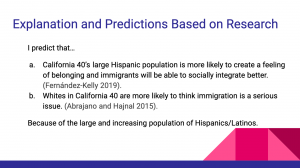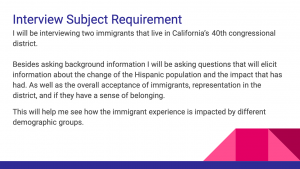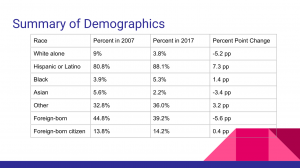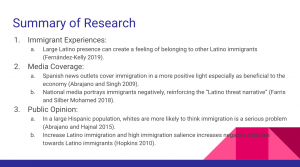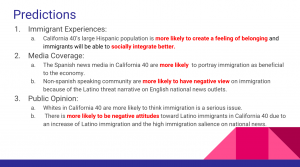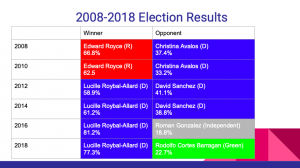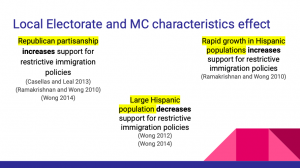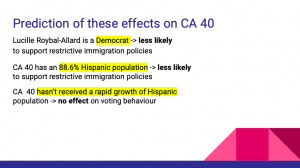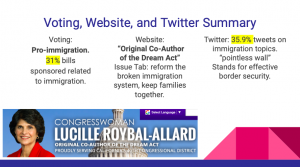Summary:
California 40 contains the cities of Downey, Vernon, East Los Angeles, Commerce, Los Angeles, Cudahy, and more. This district has an 88.2% Hispanic population, which has increased by 7.3 percentage points in the last 10 years, with a 39.2% foreign-born population. California 40 is a wildly Democratic district, in the last 20 years Democratic Representative Lucille Roybal-Allard has been re-elected with over 60% of the votes; meanwhile, there hasn’t been a Republican candidate since 2012. Based on the research by Casellas and Leal 2013, Wong 2014, and Rocha et al 2011, a representative of California 40 should be extremely pro-immigration and push to protect immigrants’ rights. Representative Roybal-Allard has been doing just that and she should continue her representation. I argue that a representative should even push for more liberal immigration policies. It is the responsibility of representatives to work on expansive immigration reform that will defend immigrants’ rights. They should work with Customs and Border Protection (CBP) to protect the borders instead of policing the interior, reform the detainment system to be more humane, and improve the immigration system to make legal immigration easier.
Op-Ed:
In late March 2019, the LA Times reported on Immigration and Customs Enforcement (ICE) using police department information to track undocumented immigrants in sanctuary cities. Undocumented immigrants are not safe, even in sanctuary cities meant to protect them. It is the responsibility of representatives to work on expansive immigration reform that will defend immigrants’ rights. They should work with Customs and Border Protection (CBP) to protect the borders instead of policing the interior, reform the detainment system to be more humane, and improve the immigration system to make legal immigration easier. California’s 40th congressional district only has a small piece of Los Angeles -a sanctuary city- but the majority of the cities in the district are not sanctuary cities which means that undocumented immigrants there are at even more risk. Due to the large Democrat, Hispanic/Latino, and immigrant population in California 40, representatives in this district must work to protect immigrant rights and push for pro-immigration bills.
California 40 contains the cities of Downey, Vernon, East Los Angeles, Commerce, Los Angeles, Cudahy, and more. This district has an 88.2% Hispanic population, which has increased by 7.3 percentage points in the last 10 years, with a 39.2% foreign-born population. California 40 is a wildly Democratic district, in the last 20 years Democratic Representative Lucille Roybal-Allard has been re-elected with over 60% of the votes; meanwhile, there hasn’t been a Republican candidate since 2012. Representative Roybal-Allard votes very pro-immigration and many of her bill sponsorships are related to immigration. She calls for a reform of the immigration system by providing a pathway for the legalization of law-abiding immigrants. She also calls for more efficient border security and a cap on ICE detainment beds to focus them on detaining criminals and not innocent civilians. Her website describes her as “Original Co-Author of the Dream Act” to show that she fought for a path for legalization. This shows that immigration is an important issue for her and her constituents. I think that this representation must continue because it accurately shows the preferences of her constituents.
A representative of California 40 should be pro-immigration because of the district’s strong support of Democrats, which Representative Lucille Roybal-Allard is. Casellas and Leal researched Congress votes to determine what factors may explain votes. They showed that “the key explanatory variables in both the House and Senate involve partisanship… Republicans were particularly favorable toward restrictive and enforcement approaches and opposed to comprehensive legislation, while Democrats took the opposite approach” (Casellas and Leal 2013). The constituents in California 40 tend to favor more comprehensive immigration legislation. Therefore, a representative for this district needs to favor comprehensive legislation, like Representative Roybal-Allard has been doing.
California 40 is a largely Hispanic district which means that a representative ought to support pro-immigration legislation. Wong researched Congressional votes on interior enforcement bills. He stated that “the size of the Hispanic/Latino percentage of the total population in a district is significantly related to a decreased likelihood of supporting legislation that tightens interior immigration enforcement for both Republican and Democratic representatives” (Wong 2014, 393). California 40 is more likely to be against tightening interior immigration enforcement. Therefore, to best represent their constituents, local representatives should be against tightening interior immigration enforcement and focus on protecting the immigrants in their district. Representative Roybal-Allard works on putting a cap on ICE detainment beds, which is a step in the right direction to restrict interior enforcement. I argue that they should even work on encouraging CBP to protect the border instead of policing immigrants already in the country, this would help to protect immigrants in the district.
Being in a mostly Hispanic district, local representatives ought to be pro-immigration to represent their constituents. Rocha et. al., researched the policy preferences of Anglos and Latinos. They state “… that Latinos in these same areas [areas with a higher proportion of Latinos] are more likely to have liberal immigration policy preferences. We further found that this result is not driven by the size of the foreign-born Latino population, but by the size of the native-born Latino population” (Rocha et al 2011, 16-17). While California 40 has a decent size foreign-born population, the majority of the population is native-born and Hispanic. This means that most of the constituents have more liberal immigration policy preferences. Representative Roybal-Allard does push for more liberal immigration policies like a pathway to legalization that would help undocumented immigrants on the inside. In addition, local representatives should support even more liberal immigration policies, for example, policies that would reform the detainment system on the border and help facilitate an easier legal immigration process.
This prior research shows that a representative of California 40 should be pushing for expansive bills and showing support for immigration. I argue that they need to be pushing for a reform of the immigration system, encouraging a more humane immigration process that will not separate families, and make it easier to enter the country legally. Representative Roybal-Allard is doing a great job of representing her constituents on the issue of immigration. It is important to be aware of the policy preferences of the constituents in California 40 because it helps representatives accurately represent their district and help the immigrants in their district. Immigration has been a large and necessary part of the United States’ history. Undocumented immigrants are an important part of our economy and are needed to fill many unwanted jobs, like jobs in agriculture, construction, and hospitality. Many undocumented immigrants even pay taxes, as seen in data provided by NewAmericanEconomy.org. They also don’t get social security benefits, even when they pay taxes. Representatives should work on helping these undocumented immigrants that are already in the country. We also need to work on facilitating legal immigration to avoid further illegal immigration. A representative in California 40 needs to protect the immigrants in their district from ICE using police department mass information to track them down because it is their duty to represent the constituents that support immigrants.

